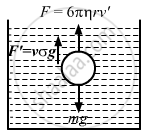Advertisements
Advertisements
Question
A metal sphere of radius 1 mm and mass 50 mg falls vertically in glycerine. Find (a) the viscous force exerted by the glycerine on the sphere when the speed of the sphere is 1 cm s−1, (b) the hydrostatic force exerted by the glycerine on the sphere and (c) the terminal velocity with which the sphere will move down without acceleration. Density of glycerine = 1260 kg m−3 and its coefficient of viscosity at room temperature = 8.0 poise.
Solution
Given:
Radius of metallic sphere r = 1 mm = 10−3 m
Speed of the sphere v = 10−2 m/s
Coefficient of viscosity η = 8 poise = 0.8 decapoise
Mass m = 50 mg = 50 × 10−3 kg
Density of glycerin σ = 1260 kg/m3
(a) Viscous force exerted by glycerine on the sphere F = 6πηrv
⇒ F= 6 × (3.14) × (0.8) × 10−3 × (10−2)
= 1.50 × 10−4 N
(b) Let V be the volume of the sphere.
Hydrostatic force exerted by glycerin on the sphere
\[F' = V\sigma g\]
\[\Rightarrow F' = \frac{4}{3}\pi r^2 \sigma g\]
\[= \left( \frac{4}{3} \right) \times \left( 3 . 14 \right) \times \left( {10}^{- 6} \right) \times 1260 \times 10\]
\[ = 5 . 275 \times {10}^{- 5} \text{N}\]
(c) Let the terminal velocity of the sphere be v'.
The forces acting on the drops are
(i) The weight mg acting downwards
(ii) The force of buoyance, i.e., \[\frac{4}{3}\pi r^3 \sigma g\] acting upwards
(iii) The force of viscosity, i.e., 6πηrv' acting upwards
From the free body diagram:

\[6\pi\eta r v' + \frac{4}{3}\pi r^3 \sigma g = \text{ mg}\]
\[ \Rightarrow v = \frac{\text{ mg }- \frac{4}{3}\pi r^2 \sigma g}{6\pi\eta r}\]
\[ = \frac{50 \times {10}^{- 3} - \frac{4}{3} \times 3 . 14 \times {10}^{- 6} \times 1260 \times 10}{6 \times 3 . 14 \times 0 . 8 \times {10}^{- 3}}\]
\[ = \frac{500 - \frac{4}{3} \times 3 . 14 \times {10}^{- 3} \times 1260 \times 10}{6 \times 3 . 14 \times 0 . 8}\]
\[ = 2 . 3 \text{ cm/s }\]
APPEARS IN
RELATED QUESTIONS
Fill in the blanks using the word(s) from the list appended with each statement
Viscosity of gases. .. with temperature, whereas viscosity of liquids . . . with temperature (increases / decreases)
The force of viscosity is
The viscous force acting between two layers of a liquid is given by \[\frac{F}{A} = - \eta\frac{dv}{dz}\]. This F/A may be called
Water flows at a speed of 6 cm s−1 through a tube of radius 1 cm. Coefficient of viscosity of water at room temperature is 0.01 poise. Calculate the Reynolds number. Is it a steady flow?
With an increase in temperature, the viscosity of liquid and gas, respectively will __________.
In a horizontal pipe of non-uniform cross-section, water flows with a velocity of 1 ms−1 at a point where the diameter of the pipe is 20 cm. The velocity of water (1.5 ms−1) at a point where the diameter of the pipe is (in cm)
Distinguish between streamlined flow and turbulent flow.
What is Reynold’s number? Give its significance.
A block of Ag of mass x kg hanging from a string is immersed in a liquid of relative density 0.72. If the relative density of Ag is 10 and tension in the string is 37.12 N then compute the mass of Ag block.
Why two holes are made to empty an oil tin?
Analogy
Viscous force: ______:: Buoyant force: ______.
The velocity of a small ball of mass M and density d, when dropped in a container filled with glycerine becomes constant after some time. If the density of glycerine is `"d"/2`, then the viscous force acting on the ball will be ______
The velocity of a small ball of mass M and density d, when dropped in a container filled with glycerine becomes constant after some time. If the density of glycerine is `"d"/2` , then the viscous force acting on the ball will be ______.
With increase in temperature, the viscosity of ______.
- gases decreases.
- liquids increases.
- gases increases.
- liquids decreases.
Is viscosity a vector?
An air bubble of negligible weight having radius r rises steadily through a solution of density σ at speed v. The coefficient of viscosity of the solution is given by ______.
State the formula and S.I. units of coefficient of viscosity.
An incompressible liquid is flowing through a uniform cross-sectional tube with a velocity 12 cm/ s. If the thickness of liquid layer is 0.8 cm, what is the velocity gradient of that flow of liquid?
